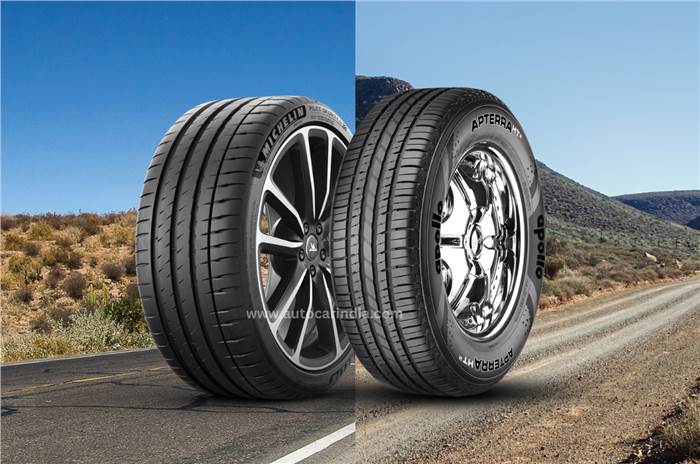We explain how to select the right tyre profile, size and compound for your car.
Manufacturers invest heavily in fine-tuning a vehicle’s dynamics, which is dependent on multiple factors, with tyres being one of the more important ones. OEMs pick a tyre size for a vehicle after analysing parameters such as longevity, performance, efficiency, safety and more. Hence, once the first set is worn out, a safe bet is to replace these with a new set bearing the exact specifications. It’s possible that you aren’t completely satisfied with the way the stock tyres perform, so if you want to elevate the driving experience, here’s what you must know in order to pick the right set.
Tyre life

Before getting to the basics of a tyre, it is important to understand the right time to change your vehicle’s tyres. The most common indicator is tread depth; tyres wear out with usage and the grooves eventually flatten, impacting performance and grip. Even those with limited usage must change their vehicle tyres every five to six years, as over time, these develop cracks that could compromise safety. The tyre compound also becomes hard and feels brittle.
Tyre contact patch
To know the exact specification of your OEM tyre, look for a number that reads something like this: ‘195/55 R16’ on the sidewall where ‘195’ determines the width of the contact patch in millimetres. As a rule of thumb, it is safe to upsize the width by 20mm without upsizing to a broader rim. Besides sportier looks and an improved vehicle stance, wider tyres improve grip, cornering abilities and braking. On the flip side, a wider contact patch will increase rolling resistance, which in turn impacts fuel efficiency.
Choosing the right tyre profile
The number ‘55’ from our above example is the tyre profile. It represents the sidewall height, which is a percentage of the tyre width; 107mm in this case (55 percent of 195mm). The sidewall is the first point of contact responsible for absorbing road shocks—thicker sidewalls provide better cushioning, so if you’re after comfort, high profile tyres are the ones to get. Conversely, low profile tyres have relatively less tyre flex, which improves handling and steering feel, but compromises comfort.
Upsizing your tyres
The next number of interest is ‘R16’, where R refers to radial tyre construction and ‘16’ is the diameter of the rim in inches. Remember, there’s little scope to deviate from the total diameter of the tyre (wheel rim + sidewall), but increasing the overall diameter by three percent is within safe limits. Hence, if you want to upsize your wheels, it’ll come at the cost of sidewall thickness.

Lower sidewall (left) gives you a sportier drive while a taller sidewall (right) gives you a comfier ride.
But remember, if you go for a size too large, it could rub against the fenders or wheel arches while taking turns and over bumps. Most owners upsize their wheels purely from an aesthetic standpoint, and this can increase weight and unsprung mass, thereby affecting ride quality. But some wheels are lighter than the factory wheels, so look for these instead.
Picking the right tyre compound
Tyre manufacturers use different compound mixes of natural and synthetic rubber, and silica and carbon black for better performance, efficiency and life. A harder compound will be more durable and have a longer life, and though a softer compound will offer better grip and ride comfort, it’s likely to be more expensive. And since they wear out quicker, they’ll have to be replaced more frequently. Thus, read the manufacturer’s claims and choose a tyre that offers what you are looking for, running life or comfort.
Off-road tyres

Most 4x4s these days, even the most hardcore ones, are fitted with all-terrain tyres (A/T) that offer the right balance between off-road capabilities, and on-road handling and comfort. These have a longer life than highway tyres (H/T) as the latter is more comfort-oriented. However, for extreme off-roading, mud tyres (M/T) are the way to go—these have large, aggressive tread blocks and deep voids to provide maximum traction in challenging conditions like deep mud and rocky terrains. Do keep in mind that their on-road behaviour is compromised in terms of comfort, noise and grip.
Snow tyres

Given the Indian climate, we typically use all-weather tyres. However, in very cold regions, you would be better off with winter tyres that have a softer compound. They have a higher natural rubber content, helping them stay supple in low temperatures. The tread pattern too has been specifically designed to dissipate snow. Despite these, to tackle deep snow, it’s best to either fit snow chains or special snow tyres that have embedded metal studs.
Tyres for EVs

Many manufacturers have specially engineered tyres for electric vehicles. While EV tyres are largely similar to other road tyres, these are designed to handle the additional weight of EVs. Plus, they have lower rolling resistance, in the interest of maximising efficiency. Some manufacturers also focus on reducing tyre noise, which is usually amplified in EVs due to the absence of any powertrain noises.
Also see:





























